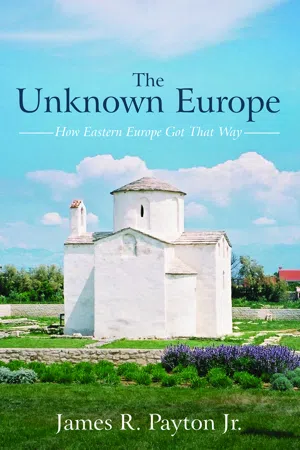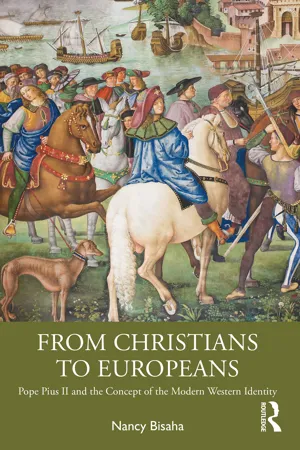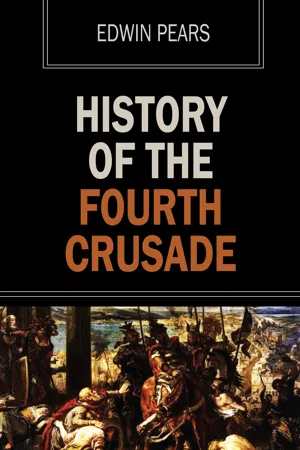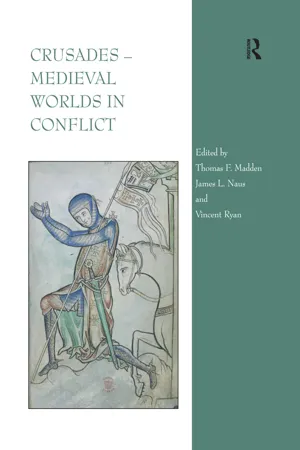History
Sack of Constantinople
The Sack of Constantinople refers to the conquest and plunder of the Byzantine capital by the Latin Crusaders in 1204 during the Fourth Crusade. The city was subjected to widespread looting, destruction, and violence, leading to the fall of the Byzantine Empire and the establishment of a Latin state in Constantinople for a brief period. This event had significant and lasting repercussions for the Byzantine Empire and the wider Christian world.
Written by Perlego with AI-assistance
Related key terms
5 Key excerpts on "Sack of Constantinople"
- eBook - ePub
The Unknown Europe
How Eastern Europe Got That Way
- James R. Payton(Author)
- 2021(Publication Date)
- Cascade Books(Publisher)
chapter 9The Fourth Crusade (12 0 4 )
“The Crusaders’ Sack of Constantinople is one of the most ghastly and tragic incidents in history. . . . The price was the lasting enmity of Greek Christendom. The Fourth Crusade could never be forgiven nor forgotten by the Christians of the East.”131On May 4 , 2001 , at a meeting with the Greek Orthodox archbishop of Athens, Pope John Paul II startled his host by asking forgiveness for the Fourth Crusade, which sacked, pillaged, and looted Constantinople, the chief city of Eastern Christianity. Few people in the West even know what happened in the Fourth Crusade: they may know a little about the crusades, but most are unaware of what happened during the fourth one.In contrast, virtually all Eastern Europeans know about that crusade all too well. As a Pole, John Paul II was acquainted with it in a way no other pope had been since the event. As head of the church whose crusaders so long ago perpetrated its horrors, this Polish pope knew just how painful a memory the Fourth Crusade has been for centuries to many Eastern Europeans.It is striking that the head of the Roman Catholic church asked forgiveness for what the crusaders had done so long ago. After the Fourth Crusade, 760 years elapsed before a pope and an ecumenical patriarch (from Constantinople, the leading hierarch of the Orthodox world) even met face to face, when Pope Paul VI and the Ecumenical Patriarch Athenagoras I did so in 1964 . That gives some sense of the deep rift opened up by the Fourth Crusade. But the 19 64 event went no further than an embrace and a polite kiss on the cheek; in 2001 , the pope asked forgiveness for what had happened in 1204 . For multiplied centuries, the Eastern Orthodox have lived with the pain, remembering the horror of what took place in 1204 - eBook - ePub
The Fall of Constantinople to the Ottomans
Context and Consequences
- Michael Angold(Author)
- 2014(Publication Date)
- Routledge(Publisher)
CHAPTER 1 The fall of Constantinople as a turning pointT he fall of Constantinople is a story that has often been told. It is Sir Steven Runciman who tells the story best in his Fall of Constantinople 1453, which is a consummate example of history as narrative, but even he was beginning to wonder whether the topic merited another book.1 He did not think that over the details of the siege he had much to add to the account given by Sir Edwin Pears in his Destruction of the Greek Empire, which originally appeared in 1903, the year of Runciman’s birth.2 Runciman’s hesitations have not prevented others from undertaking the retelling of the story of the fall of Constantinople. The most recent attempt by M. Philippides and W.K. Hanak is on a massive scale and provides a convincing and detailed reconstruction of the event.3 It is not my intention to provide yet another narrative or to attempt another reconstruction. The focus of my interest will be on the historical significance of the fall of Constantinople to the Ottomans. Was it one of history’s turning points? Such an approach will necessarily highlight its prehistory and its consequences, at the expense of the event itself. But it makes little sense to write about the fall of Constantinople without first providing a brief sketch of those desperate days in April and May 1453.IThe decision taken by the young Sultan Mehmed II (1451–81) to embark on the conquest of Constantinople represented the failure of political arrangements, which for fifty years had allowed Byzantium to survive and to a degree to prosper. He blamed the Byzantine emperor for the political crisis at the heart of the Ottoman ruling institution, which had overshadowed his boyhood. We are never going to know exactly what the forces were which in 1444 persuaded his father Murad II to abdicate in favour of his son, who was not quite thirteen.4 There are, however, pointers, such as rumours that the young Mehmed – or at least the men behind him – were agitating for an attack on Constantinople. There was deep suspicion of the Byzantine emperor, who was blamed for orchestrating a series of Hungarian invasions of the Ottoman Empire, which were only beaten off with great loss of life.5 Some at the Ottoman court were beginning to see an independent Constantinople as a threat to security. They also resented the ascendancy exercised over Murad II by his Grand Vezir Çandarli Halil Pasha, who was an advocate of entente with Byzantium. The conquest of Constantinople will no doubt have appealed to Mehmed II’s youthful bravado nurtured by reading about the exploits of Alexander the Great. Encouraging him was a clique at the Ottoman court, which in the search for preferment had attached itself to the young sultan. From the names that we have they seem to have been predominantly from Christian families, but converts to Islam brought up at the Ottoman court. They were slave administrators and represented a new political force, which emerged as an Ottoman central government began to take clearer shape. They had a vested interest in extending the effective authority of the sultan, but were frustrated by Murad II, who preferred to maintain the status quo, ably seconded by his Grand Vezir. His was always the voice of moderation. When in 1437 Sultan Murad II was contemplating a punitive expedition against Constantinople, there was one dissenting voice, that of Halil Pasha. He argued that any attack on Constantinople would throw the emperor into the arms of the Latins. It was better to let matters take their course, since the Ottomans had little to fear, protected as they were by a series of treaties.6 - eBook - ePub
From Christians to Europeans
Pope Pius II and the Concept of the Modern Western Identity
- Nancy Bisaha(Author)
- 2023(Publication Date)
- Routledge(Publisher)
The History of Mehmed the Conqueror, ed. and tr. Charles T. Riggs (Princeton: Princeton University Press, 1954), 76.- For details on the siege and sack see Marios Philippides and Walter K . Hanak, The Siege and the Fall of Constantinople in 1453 (Burlington, VT: Ashgate, 2011); Kenneth Setton, The Papacy and the Levant (1205–1571), vol. 2 (Philadelphia: American Philosophical Society, 1978); the most readable treatment of the siege is Steven Runciman, The Fall of Constantinople: 1453 (Cambridge: Cambridge University Press, 1965). One of the best eyewitness accounts is that of Leonard of Chios, “History of the Capture of Constantinople by Mehmed II,” in The Siege of Constantinople 1453: Seven Contemporary Accounts, tr. and ed. J. R. Melville Jones (Amsterdam: Adolf M. Hakkert, 1972), 11–41. See also Donald Nicol, Immortal Emperor: The Life and Legend of Constantine Palaiologos, Last Emperor of the Romans (Cambridge: Cambridge University Press, 1992). For a recent and more critical assessment of Constantine, see Marios Philippides, Constantine XI Dragaš Palaeologus: The Last Emperor of Byzantium (London: Routledge, 2019). On Constantinople as a “God-given city,” see, Jonathan Harris, Constantinople: Capital of Byzantium (London: Hambledon Continuum, 2007).
- The barrel was probably between twenty and twenty-six feet in length and six to eight feet in circumference , with a breach of about two feet in circumference. Contemporary estimates of the weight of the projectiles range from 11,000–18,000 pounds. The cannon required thirty wagons and sixty oxen to transport it. See Philippides and Hanak, Siege and the Fall of Constantinople in 1453, 418–25.
Contemporary chronicler Doukas recounts conversations with Ottoman soldiers who participated in the sack as saying they would have “sold [the Greeks] like sheep” had they known how few men were actually defending the city; Doukas, Decline and Fall of Byzantium, ed. and tr. Harry Magoulias (Detroit: Wayne State University Press, 1975), 224–25. Eyewitness Leonard of Chios, states that those who surrendered were spared, but also notes widespread seizure of inhabitants, Siege of Constantinople - eBook - ePub
- Edwin Pears(Author)
- 2018(Publication Date)
- Ozymandias Press(Publisher)
The Greek eye-witness gives the complement of the picture of Villehardouin. The lust of the army spared neither maiden nor the virgin dedicated to God. Violence and debauchery were everywhere present; cries and lamentations and the groans of the victims were heard throughout the city; for everywhere pillage was unrestrained and lust unbridled. The city was in wild confusion. Nobles, old men, women, and children ran to and fro trying to save their wealth, their honor, and their lives. Knights, foot-soldiers, and Venetian sailors jostled each other in a mad scramble for plunder. Threats of ill-treatment, promises of safety if wealth were disgorged, mingled with the cries of many sufferers. These pious brigands, as Gunther aptly calls them, acted as if they had received a license to commit every crime. Sword in hand, houses and churches were pillaged. Every insult was offered to the religion of the conquered citizens. Churches and monasteries were the richest storehouses, and were therefore the first buildings to be rifled. Monks and priests were selected for insult. The priests’ robes were placed by the Crusaders on their horses. The icons were ruthlessly torn down from the screens or were broken. The sacred buildings were ransacked for relics or their beautiful caskets. The chalices were stripped of their precious stones and converted into drinking-cups. The sacred plate was heaped with ordinary plunder. The altar-cloths and the screens of cloth-of-gold, richly embroidered and bejewelled, were torn down, and either divided among the troops or destroyed for the sake of the gold and silver which were woven into them. The altars of Hagia Sophia, which had been the admiration of all men, were broken for the sake of the material of which they were made. Horses and mules were taken into the church in order to carry off the loads of sacred vessels and the gold and silver plates of the throne, the pulpits, and the doors, and the beautiful ornaments of the church. The soldiers made the chief church of Christendom the scene of their profanity. A prostitute was seated in the patriarchal chair, who danced, and sang a ribald song for the amusement of the soldiers. Nicetas, in speaking of the desecration of the Great Church, writes with the utmost indignation of the barbarians who were incapable of appreciating and therefore respecting its beauty. To him it was an “earthly heaven, a throne of divine magnificence, an image of the firmament created by the Almighty.”The plunder of the same church in 1453 by Mahomet the Second compares favorably with that made by the Crusaders of 1204.The sack of the city went on during the three days after the capture. An order was issued, probably on the third day, by the leaders of the army, for the protection of women. Three bishops had pronounced excommunication against all who should pillage church or convent. It was many days, however, before the army could be reduced to its ordinary condition of discipline. A proclamation was made throughout the army that all the booty should be collected, in order to be divided fairly among the captors. Three churches were selected as depots, and trusty guards of Crusaders and Venetians were stationed to watch what was thus brought in. Much, however, was kept back, and much stolen. Stern measures had to be resorted to before order was restored. Many Crusaders were hanged. The Count of St. Paul hung one of his own knights with his shield round his neck because he had not given up the booty he had captured. A contemporary writer, the continuator of the history of William of Tyre, forcibly contrasts the conduct of the Crusaders before and after the capture. When the Latins would take Constantinople they held the shield of God before them. It was only when they had entered that they threw it away, and covered themselves with the shield of the devil.I have already mentioned that the Italians resident in Constantinople who had returned to the city with their countrymen were conspicuous in their hostility to the Greeks. Amid this resentment there were examples, however, that former friendships were not forgotten. The escape of Nicetas himself is an illustration in point. He had held the position of Grand Logothete, - eBook - ePub
- Thomas F. Madden, James L. Naus, Vincent Ryan(Authors)
- 2017(Publication Date)
- Routledge(Publisher)
The Fourth Crusade: Event and Context (Harlow, UK, 2003). On the contentious historiography of the Fourth Crusade, see Thomas Madden, “Outside and Inside the Fourth Crusade,” International History Review 17 (1995): 726–43.Passage contains an image
Chapter 8“Like an Ember Buried in Ashes:” The Byzantine–Venetian Conflict of 1119–1126 1
Thomas DevaneyBrown UniversityWhen called to the aid of the Crusaders after the Ager Sanguinis in 1119, Doge Domenico Michiel of Venice provided a fleet to assist in the conquest of Tyre. He also seized the opportunity to further Venetian interests. On both its outbound and return voyages, the Venetian Crusading expedition raided Byzantine islands in an attempt to force Emperor John II Comnenus (1118–1143) to restore trading privileges revoked a few years earlier. This essay investigates the particulars of this conflict, which set the tone for later relations. Although tensions had existed between Venice and the Byzantine Empire before this time, they had maintained a close military and economic association, in which Byzantium was the senior partner. However, Venice’s successful campaign to force John II into granting concessions established a new hierarchy in the relationship. Though later emperors sought to contain the Venetians, they would not again be able to treat them as inferior partners. Further, the conflict created an atmosphere of mistrust that would taint all future interactions.The Venetian role in the Fourth Crusade and the conquest of Constantinople in 1204 has been the subject of much debate. Though many scholars have challenged the argument that the crusade was “diverted” by the Venetians for their own purposes, questions about relations between Byzantium and Venice remain relevant to this controversy, with Manuel I’s 1171 expulsion of all Venetians from the empire commonly cited as the point of divergence for Byzantium and Venice. However, the Venetian raids in 1123–1126 marked the first open conflict between Byzantium and Venice. It is to this confrontation that one should look for the roots of later discord.
Index pages curate the most relevant extracts from our library of academic textbooks. They’ve been created using an in-house natural language model (NLM), each adding context and meaning to key research topics.




